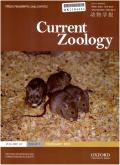Lesser kestrels of the same colony do not overwinter together
IF 2
2区 生物学
Q2 ZOOLOGY
引用次数: 0
Abstract
Migratory connectivity describes the linkage between breeding and non-breeding sites, having major ecological implications in birds: one season influence the success of an individual or a population in the following season. Most studies on migratory connectivity have used large-scale approaches, often considering regional populations, but fine-scale studies are also necessary to understand colony connectivity. The lesser kestrel Falco naumanni, an insectivorous migratory raptor which form colonies during the breeding period, was considered to have strong connectivity based on regional populations. However, no small scale studies on migratory connectivity have been conducted. Therefore, we GPS-tracked 40 adult lesser kestrels from 15 different Spanish breeding colonies, estimating the overlap index between home ranges and the distance between their centroids. It was found that lesser kestrels from the same breeding colony placed their non-breeding areas at 347 ± 281 km (mean ± standard deviation) away from each other (range = 23-990), and their home ranges overlapped by 38.4 ± 23.6%. No differences between intra-colony and inter-colony metrics were found, which suggests that lesser kestrels from the same breeding cluster do not overwinter together, but they spread out and mixed independently of the colony belonging throughout the non-breeding range of the species. Ultimately, this study highlights the importance of performing connectivity studies using fine-scale approaches.同一种群的小红隼不会一起越冬
迁徙连通性描述了繁殖地和非繁殖地之间的联系,对鸟类具有重要的生态影响:一个季节影响个体或种群在下一个季节的成功。大多数关于迁徙连通性的研究都使用了大规模的方法,通常考虑区域种群,但精细尺度的研究对于理解群体连通性也是必要的。小红隼Falco naumanni是一种食虫迁徙猛禽,在繁殖期间形成殖民地,被认为具有基于区域种群的强连通性。然而,对迁徙连通性的小规模研究尚未开展。因此,我们用gps跟踪了来自15个不同的西班牙繁殖地的40只成年小红隼,估计了它们的家园范围和它们的中心点之间的距离的重叠指数。结果表明,来自同一繁殖群体的小红隼的非繁殖区距离为347±281 km(平均±标准差)(范围为23 ~ 990),其活动范围重叠度为38.4±23.6%。在群体内和群体间没有发现差异,这表明来自同一繁殖群的小红隼不会在一起越冬,而是在属于该物种非繁殖范围的群体中独立地扩散和混合。最后,本研究强调了使用精细尺度方法进行连通性研究的重要性。
本文章由计算机程序翻译,如有差异,请以英文原文为准。
求助全文
约1分钟内获得全文
求助全文
来源期刊

Current Zoology
Agricultural and Biological Sciences-Animal Science and Zoology
CiteScore
3.20
自引率
9.10%
发文量
111
审稿时长
6 weeks
期刊介绍:
About the Journal
Current Zoology (formerly Acta Zoologica Sinica, founded in 1935) is an open access, bimonthly, peer-reviewed international journal of zoology. It publishes review articles and research papers in the fields of ecology, evolution and behaviour.
Current Zoology is sponsored by Institute of Zoology, Chinese Academy of Sciences, along with the China Zoological Society.
 求助内容:
求助内容: 应助结果提醒方式:
应助结果提醒方式:


